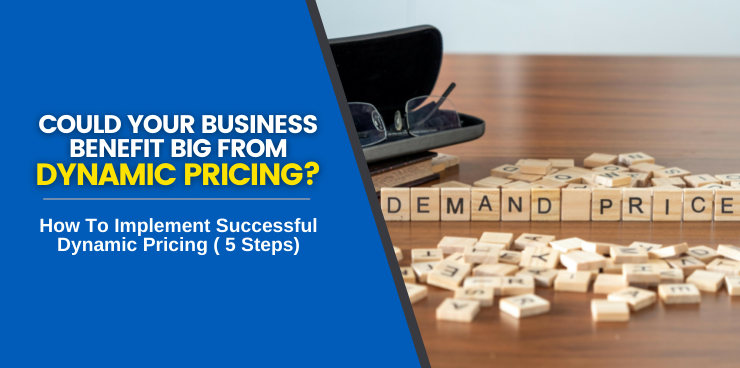We’ve all been here before: you’re looking at flights to go visit grandma, and with each day that goes by, the airfare price changes — jumping up and down more times than you can even keep track of.
But what makes airfare so prone to such fluctuating prices?
They are selling to the masses.
And who also sells to the masses? Home service businesses.
Airline companies are aware of the two types of passengers that board their flights: leisure and business travelers. Both of them need to catch that flight, but their buying behavior is different. Leisure travelers are more flexible with dates, while business travelers have a tight window to work with.
Home service businesses work similarly. They understand that their customers fall into different categories, each with distinct needs and purchasing behaviors. Many of these companies use dynamic pricing to better cater to these customer segments.
The dynamic pricing strategy is all about knowing your customer and playing around with the prices to get the most out of each sale. So what exactly is dynamic pricing, and how do I know if it’ll work for my business?
In this article, we’ll take a closer look at dynamic pricing, how to implement it, and the various strategies of segmented pricing used today.
What is Dynamic Pricing?
Dynamic pricing is a popular pricing strategy used by many businesses today. Also known as surge pricing, time-based pricing, or demand pricing.
Dynamic pricing allows businesses to set flexible prices based on market demands. This enables companies to continuously adjust pricing in response to changing consumer trends and buyer preferences.
Many different factors can impact dynamic pricing strategies, including consumer demand, competition in the market, and supply availability.
For example, if there is high consumer demand for a particular product or service, dynamic pricing may increase prices to reflect this increased demand.
Similarly, if there is little product available or strong competition in the market, dynamic pricing may decrease prices to better compete with other sellers.
At Wizard of Sales®, we have extensive experience helping businesses implement dynamic pricing strategies that work for their specific products, services, and goals.
To learn more, book a demo with us today!
How Do You Implement Dynamic Pricing?
The thought of re-drawing the map of your pricing strategy can feel quite frightening, but the benefits of dynamic pricing can make it well worth the time and effort.
The more you know how to implement it, the better your results will be. Here are some tips to get you started on the path to variable pricing.
1. Define your objective
To implement dynamic pricing, you first need to define your objective. Having a solid objective is important as it will help you make decisions and further refine your pricing strategies.
In determining an objective, consider the following questions:
- What are your long-term goals for your business?
- Do you want to increase your market share?
- Do you want to enter new markets?
- Do you want to improve customer satisfaction or loyalty?
Once you have determined your objective, you can begin to develop pricing strategies that will help you reach your goal.
Some common objectives include increasing revenue and reducing costs, enticing consumers to try new products, and getting consumers back on a brand’s loyalty program.
2. Create a price plan
Your price plan will set you up for a smooth transition to dynamic pricing. By outlining your current pricing strategy and how you want to change it, you can make sure that your prices are updated in a way that makes sense for your business.
To start, take a look at your current pricing strategy. What are your prices based on? Are they static, or do they fluctuate based on certain factors? What is the current price you charge for your service or product?
To plan for a smooth transition to dynamic pricing, consider these steps:
a. Analyze your current pricing strategy.
b. Identify any factors that may influence how you set your prices in the future, such as market demand, competition, and your product or service’s perceived value.
c. Brainstorm potential pricing strategies that could work well for your business, and think about how you can implement dynamic pricing in a way that makes sense for your customers.
d. Devise an implementation plan with specific goals, timelines, and metrics to measure whether the strategy is working.
e. Communicate your plans to your team and customers, and be prepared to make changes if necessary.
Dynamic pricing can be a great way to optimize your profits and better respond to customer demand. By taking the time to plan ahead, you can ensure that your transition to this type of pricing is successful.
3. Select your pricing strategy
Once you’ve got your pricing plan set up, you’ll need to start thinking about how you want to price your products.
There are several different pricing strategies that you can use, and each has its own benefits and drawbacks. The most commonly used are segmented pricing, time-based pricing, changing market conditions, peak pricing, and penetration pricing.
We’ll unpack these strategies in a bit, but what’s important to know right now is that there is no one-size-fits-all solution. The pricing strategy that you use will depend on your products, your business goals, and the specific market conditions in which you’re operating.
4. Create pricing guidelines
You’ve got a seamless strategy, now it’s time to introduce a pricing structure. Your first step should be to create business guidelines for various product categories, based on your customers’ preferences.
If your primary audience is the higher-end market, creating a comprehensive list of guidelines for high-quality products will help you generate consistent sales through targeted price points. But if you’re dealing primarily with a value-conscious market, you’ll want to limit your guidelines to the lowest price possible for a specific product category.
One of the most important aspects of creating pricing guidelines is making sure they are consistent and accurate. You should consult historical sales data and customer surveys to identify any trends or patterns that may affect your pricing structure. Additionally, the guidelines should align with your other pricing strategies, such as sales and discounts.
You may also want to consider using an analytical tool when creating your pricing guidelines. This will help you avoid making any rash or inconsistent decisions that could affect your profits in the long-term. For example, some of the most common analytics tools include average revenue/profit per customer, cost of sale, lifetime value, revenue velocity, and gross margin.
With these analytics tools at your disposal, you can identify which marketing tactics are working for your business and which ones may be having a negative impact — either on sales or profits. Once you have these key metrics in place, it will be easier to determine how effective your dynamic pricing strategy is and whether or not you need to make any changes.
5. Put the approach into action, test it, and assess it
Take off your sunglasses in slow motion, because It’s “go” time! At this stage, you’re ready to put your new dynamic pricing strategy into action. But before you do, there are a few things you need to keep in mind:
- Test your strategy before implementing it
Testing your dynamic pricing strategy is crucial to its success. You need to make sure that your prices are reasonable and that your customers will actually respond to the changes. The best way to test your strategy is to run a series of small-scale experiments.
- Be prepared to adjust your strategy as needed
Once you’ve tested your strategy and are confident in its effectiveness, it’s time to implement it. Be prepared to make adjustments along the way, as your customer base and the market may change over time.
- Be sure to assess the results of your pricing strategy regularly
It’s important to look at your pricing strategy regularly to make sure it is still effective. If you find that your customers are no longer responding to your prices in the same way, it may be time to make some changes.
Dynamic Pricing Strategies That Exist Today
So now that you know how to implement an optimized dynamic pricing strategy, let’s look at some of the different types of dynamic pricing that we see many other companies using today.
 Segmented Pricing
Segmented Pricing
Segmented pricing involves dividing your customer base into groups, or segments, based on certain criteria.
Once you have divided your customers into segments, you can then offer different prices to each group. This allows you to tailor your pricing to better suit the needs of each segment, and ultimately increase your overall profits.
There are many different ways to segment your customer base. Some common methods include segmenting by geographical location, demographics, or even purchase history.
However, it is important to remember that there is no one perfect way to segment your customers. The best approach is often to experiment with different methods and see what works best for your business.
Time-based Pricing
Time-based pricing takes into account the time of day, week, or month when goods or services are purchased.
This type of pricing can be used to encourage customers to buy during off-peak times or to discourage them from buying during peak times.
For example, an HVAC company might offer a discount for customers who schedule their appointment during the week instead of on the weekend. This encourages customers to book appointments during times when the company is less busy and helps to even out demand.
Time-based pricing can also be used as a way to manage demand. For example, a power company might charge more for electricity during peak hours, when demand is higher. This encourages customers to use less electricity during these times and helps to prevent blackouts or other problems caused by high demand.
Changing Market Conditions
Throughout the course of a business’ life, market conditions are constantly changing. This creates a dynamic and evolving landscape for pricing strategies, requiring businesses to think creatively and strategically in order to stay competitive.
To create a strategy that will allow your business to thrive in this changing environment, you can offer dynamic pricing models that take into account customer demand and market conditions or shift your focus toward different customer segments based on their needs and purchasing behaviors.
At its core, successful pricing is about understanding what customers want and need. It requires careful analysis of factors like product demand, market dynamics, supply chain costs, and competition to find the right balance between price points that will maximize revenue while remaining profitable.
 Peak Pricing
Peak Pricing
Peak pricing is a strategy that charges higher prices during periods of high demand and lower prices during periods of low demand. This pricing strategy is often used by businesses to maximize profits and minimize losses.
Peak pricing can be a controversial pricing strategy, as it can be perceived as price gouging. However, peak pricing can also be justified as a way to manage demand and ensure that customers who really need a product or service are able to get it.
Whether or not to use peak pricing is a decision that businesses must make based on their specific needs and goals. There is no right or wrong answer, but businesses should be aware of the pros and cons of this pricing strategy before making a decision.
Penetration Pricing
Penetration pricing can be used to increase market share or jump-start sales of a new product. It involves setting a low initial price for a product to attract customers and gain market share.
The low price is often subsidized by the manufacturer in order to stimulate demand. Once the product has gained traction in the market, the price can be raised to more profitable levels.
Penetration pricing is common in markets where there are few established competitors and high barriers to entry. It can also be used as a defensive measure to deter new entrants from entering the market.
The key to successful penetration pricing is to have a clear understanding of your target market and what price point will appeal to them. It is also vital to have a well-defined strategy for how you will scale your business once you have captured market share.
How Does Dynamic Pricing Affect E-commerce?
Dynamic pricing is quite a common pricing strategy in e-commerce. In dynamic pricing, prices are constantly changing in response to market demand.
Big companies like Amazon are known for implementing dynamic pricing strategies. They’ve found great success in using this strategy to maximize profit, while at the same time keeping prices low enough that customers are still willing to buy the products.
But just because Amazon is doing it, doesn’t mean small businesses can’t get their piece of the pie too. In fact, dynamic pricing can be a great way for small businesses to stay competitive against larger companies.
This strategy is also a benefit for shoppers, as they can find lower prices during periods of low demand. However, it can also be a disadvantage, as prices may rise during periods of high demand.
Ultimately, it’s up to each business to decide whether dynamic pricing is right for them. There are pros and cons to using this strategy, and it may not be the best fit for every company. But for those who are willing to experiment with pricing, dynamic pricing can be a great way to increase profits while also keeping loyal customers happy.
Conclusion
The verdict? Price it too cheap, and you’re leaving money on the table. But price it too expensive, and you won’t make any sales at all. It’s a delicate balancing act that requires some finesse, but if done correctly, dynamic pricing can be your secret weapon for boosting profits.
Dynamic pricing is a complex beast, but when you understand all the moving parts it can be a powerful tool for your business.
We’ve walked you through the basics of how dynamic pricing works and what you need to do to get started. Now it’s time for you to take that knowledge and put it into action.
If you want help getting started or have any questions, Wizard of Sales® can help.
Book a demo with us today. We’d be happy to help your business revolutionize its sales strategy so your business can reach peak profits.



 Segmented Pricing
Segmented Pricing Peak Pricing
Peak Pricing